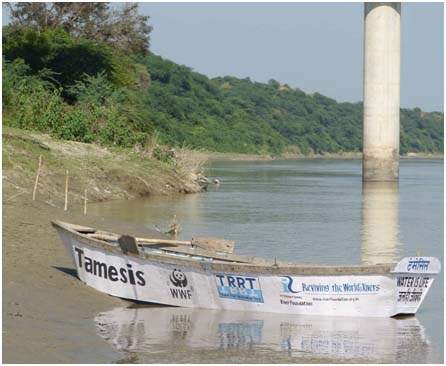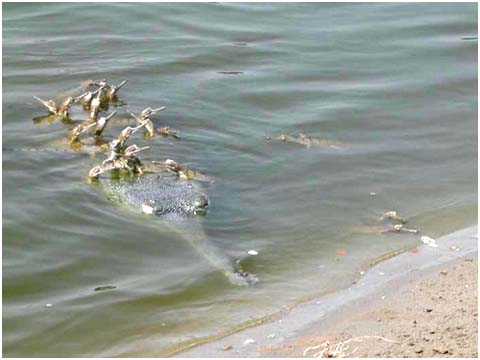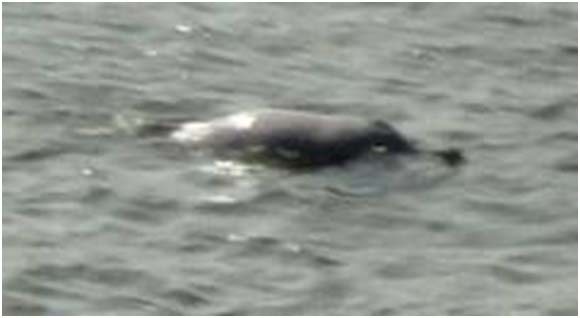Dr Peter Spillet of the Thames River Restoration Trust shared that the Trust was the recipient of the 2010 Theiss International Riverprize funds on behalf of many organizations involved in the restoration work on river Thames in United Kingdom. He said that the Trust had shared the money for twinning projects in various countries including in India.
This conference presents the results of the 2011-13 twinning programme. The Trust collaborated with PEACE and WWF to work with local communities working on Yamuna river restoration, he said.
Dr Ashghar Nawab, Senior Projects Coordinator, WWF-India noted that they ran the project on the Upper Ganges river at the Hastinapur Wildlife Sanctuary in Uttar Pradesh to re-introduce the endangered Gharial and other wildlife there and in the lower Yamuna river area. At the same time they helped local people improve their agricultural practices to improve their standard of living.
The long term plan was to ensure a viable population of Gharial with a favourable habitat through increased capacity support from the local communities. The project was to benefit fish population, freshwater turtles, Ganges river dolphins and other riverine species in the lower Yamuna river such as otters and water birds, he said.

Intensive field surveys were conducted to monitor species diversity and evaluate threats to habitat (Image courtesy: WWF-India)
In the stretch between Bateshwar Ghat, Agra to Dibholi Ghat, Etawah the frontline forest staff was trained in monitoring and assessing the Gharial population and habitat, thereby transferring WWF-India expertise in this field to the Forest Department.

Female Gharial recorded with about 18 hatchlings; this is the first record of Gharial ‘nesting’ in river Yamuna (Image courtesy: WWF-India)
In this project, work was done with the local communities to reduce dependency on river resources. Alternative livelihood options were provided by creating links with government village development schemes. Local Youth Conservation Forum was built to instill a sense of ownership for the protection of the species.
Dr Nawab stated that biodiversity conservation was inextricably linked to the protection of habitat in terms of availability of prey and suitable sites for shelter. Biodiversity recorded represents endangered species like the Ganges Dolphin, Gharial and the black-necked Stork. Peripheral areas of the National Chambal Sanctuary fall in the Yamuna, which are used as seasonal migratory routes by endangered species like Gharial.

Small population of Ganges river dolphin were observed near Pathewara village, Hamirpur (Image courtesy: S R Taigore)
Such habitats maybe recognized or proposed as conservation units needing effective protection measures on urgent basis. Technical assistance is being provided to the Forest Department in the development of a Biodiversity Conservation Action Plan for Yamuna. Riparian communities with stake in long term future of freshwater species and habitats across the region must be fully engaged in the development and conservation planning processes. This will help assure the future sustainability of associated livelihoods and the ecosystem services provided by fully functioning freshwater ecosystems.
Manoj Misra stated that PEACE’s work on the river Yamuna has evolved, and the partnership with TRRT and WWF-India is a part of this process. It started with devising and testing a People’s River Health Index (PRHI) in 2010 supported by a two-year grant from the UNDP-SGP. Findings from the PRHI project became the activities under the Twinning Project. The activities were spread over ten grids along the river Yamuna.
Nadi Mitra Mandalis (NMMs) were set up as formal registered societies at each grid and acted as instruments for action addressing the “non point” threats to the river. The focus of the project was on promotion of natural or organic farming, improved sanitation and waste water management, solid and farm refuse management, catchment restoration, river and village health assessment, institutional strengthening and outreach to school children.
Activities taken up included development of plantation, recharge well, pond and well restoration, solar lamps, eco-san toilets and repair of village drains. 6,000 trees have been planted along the river at ten locations. Monthly monitoring of river health (water quality, quantity and biodiversity) and village health parameters was being done at all the grids by the NMMs.
Dave Wardle, Twinning Project Chairman discussed the work of the Thames River Restoration Trust in improving the biologically dead river. He provided an account of how the Thames system suffered from problems such as pollution, physical alteration, low water flows and loss of wildlife habitat. The work of the Trust in improving the Thames system was discussed. He shared how TRRT helped restore the Thames and its tributaries through its policy lobbying work and by helping produce the Thames River Basin Management Plan, London Rivers Action Plan and Thames Water Resources Plan. The river is as free of pollution as possible and has been able to meet water quality standards.

Thames river (Image courtesy: Thames River Restoration Trust)
Dr. Robert Oates, Director of the Thames River Restoration Trust stated that significant stretches of the river have been restored to a natural structure, to enable functioning natural processes and sustainable ecosystems.
The technical sessions led by Bhim Rawat and Sita Ram Taigor of PEACE along with representatives of the Nadi Mitra Mandalis elaborated on the activities taken up in each grid and the experiences therein.